Increased Endogenous Activity of the Renin-Angiotensin System Reduces Infarct Size in the Rats with Early Angiotensin II-dependent Hypertension which Survive the Acute Ischemia/Reperfusion Injury
- PMID: 34122103
- PMCID: PMC8193500
- DOI: 10.3389/fphar.2021.679060
Increased Endogenous Activity of the Renin-Angiotensin System Reduces Infarct Size in the Rats with Early Angiotensin II-dependent Hypertension which Survive the Acute Ischemia/Reperfusion Injury
Abstract
We investigated the role of the interaction between hypertension and the renin-angiotensin system in the pathophysiology of myocardial ischemia/reperfusion injury. We hypothesized that in the early phase of angiotensin II (ANG II)-dependent hypertension with developed left ventricular hypertrophy, cardioprotective mechanism(s) are fully activated. The experiments were performed in transgenic rats with inducible hypertension, noninduced rats served as controls. The early phase of ANG II-dependent hypertension was induced by five-days (5 days) dietary indole-3-carbinol administration. Cardiac hypertrophy, ANG II and ANG 1-7 levels, protein expression of their receptors and enzymes were determined. Separate groups were subjected to acute myocardial ischemia/reperfusion injury, and infarct size and ventricular arrhythmias were assessed. Induced rats developed marked cardiac hypertrophy accompanied by elevated ANG levels. Ischemia/reperfusion mortality was significantly higher in induced than noninduced rats (52.1 and 25%, respectively). The blockade of AT1 receptors with losartan significantly increased survival rate in both groups. Myocardial infarct size was significantly reduced after 5 days induction (by 11%), without changes after losartan treatment. In conclusion, we confirmed improved cardiac tolerance to ischemia/reperfusion injury in hypertensive cardiohypertrophied rats and found that activation of AT1 receptors by locally produced ANG II in the heart was not the mechanism underlying infarct size reduction.
Keywords: angiotensin II receptor antagonist; hypertension; infarct size; ischemia/reperfusion injury; renin-angiotensin system.
Copyright © 2021 Husková, Kikerlová, Sadowski, Alánová, Sedláková, Papoušek and Neckář.
Conflict of interest statement
The authors declare that the research was conducted in the absence of any commercial or financial relationships that could be construed as a potential conflict of interest.
Figures

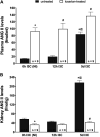
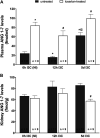

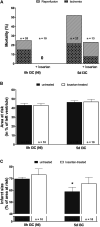
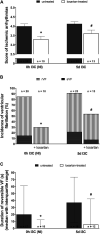
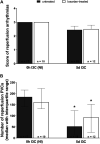
Similar articles
-
Inappropriate activation of the renin-angiotensin system improves cardiac tolerance to ischemia/reperfusion injury in rats with late angiotensin II-dependent hypertension.Front Physiol. 2023 Jun 14;14:1151308. doi: 10.3389/fphys.2023.1151308. eCollection 2023. Front Physiol. 2023. PMID: 37389123 Free PMC article.
-
The Interplay between the Renin Angiotensin System and Pacing Postconditioning Induced Cardiac Protection.PLoS One. 2016 Nov 4;11(11):e0165777. doi: 10.1371/journal.pone.0165777. eCollection 2016. PLoS One. 2016. PMID: 27814397 Free PMC article.
-
Myocardial angiotensin II receptor expression and ischemia-reperfusion injury.Vasc Med. 1998;3(2):121-30. doi: 10.1177/1358836X9800300206. Vasc Med. 1998. PMID: 9796075 Review.
-
Effects of captopril and angiotensin II receptor blockers (AT1, AT2) on myocardial ischemia-reperfusion induced infarct size.Cytokine. 2011 Dec;56(3):688-94. doi: 10.1016/j.cyto.2011.09.002. Epub 2011 Oct 4. Cytokine. 2011. PMID: 21975128
-
AT1 receptor blockade in experimental myocardial ischemia/reperfusion.J Am Soc Nephrol. 1999 Jan;10 Suppl 11:S129-36. J Am Soc Nephrol. 1999. PMID: 9892153 Review.
Cited by
-
MiR-410-3p facilitates Angiotensin II-induced cardiac hypertrophy by targeting Smad7.Bioengineered. 2022 Jan;13(1):119-127. doi: 10.1080/21655979.2021.2009968. Bioengineered. 2022. PMID: 34951337 Free PMC article.
-
Inappropriate activation of the renin-angiotensin system improves cardiac tolerance to ischemia/reperfusion injury in rats with late angiotensin II-dependent hypertension.Front Physiol. 2023 Jun 14;14:1151308. doi: 10.3389/fphys.2023.1151308. eCollection 2023. Front Physiol. 2023. PMID: 37389123 Free PMC article.
-
Preclinical multi-target strategies for myocardial ischemia-reperfusion injury.Front Cardiovasc Med. 2022 Aug 22;9:967115. doi: 10.3389/fcvm.2022.967115. eCollection 2022. Front Cardiovasc Med. 2022. PMID: 36072870 Free PMC article. Review.
-
A New Scoring System for Predicting Ventricular Arrhythmia Risk in Patients with Acute Myocardial Infarction.Clin Interv Aging. 2023 Feb 21;18:283-292. doi: 10.2147/CIA.S395121. eCollection 2023. Clin Interv Aging. 2023. PMID: 36851975 Free PMC article.
References
-
- Alánová P., Husková Z., Kopkan L., Sporková A., Jíchová Š., Neckář J., et al. (2015). Orally Active Epoxyeicosatrienoic Acid Analog Does Not Exhibit Antihypertensive and Reno- or Cardioprotective Actions in Two-Kidney, One-Clip Goldblatt Hypertensive Rats. Vasc. Pharmacol. 73 (October), 45–56. 10.1016/j.vph.2015.08.013 - DOI - PubMed
-
- Anderson P. G., Bishop S. P., Digerness S. B. (1987). Transmural Progression of Morphologic Changes during Ischemic Contracture and Reperfusion in the Normal and Hypertrophied Rat Heart. Am. J. Pathol. 129 (1), 152–167. Available at: http:///pmc/articles/PMC1899704/?report=abstract - PMC - PubMed
-
- Čertíková Chábová V., Vernerová Z., Kujal P., Husková Z., Škaroupková P., Tesař V., et al. (2014). “Addition of ETA Receptor Blockade Increases Renoprotection provided by Renin–Angiotensin System Blockade in 5/6 Nephrectomized Ren-2 Transgenic Rats. Life Sci. 118 (2). 297–305. 10.1016/j.lfs.2013.12.018 - DOI - PubMed
LinkOut - more resources
Full Text Sources
Research Materials
Miscellaneous

